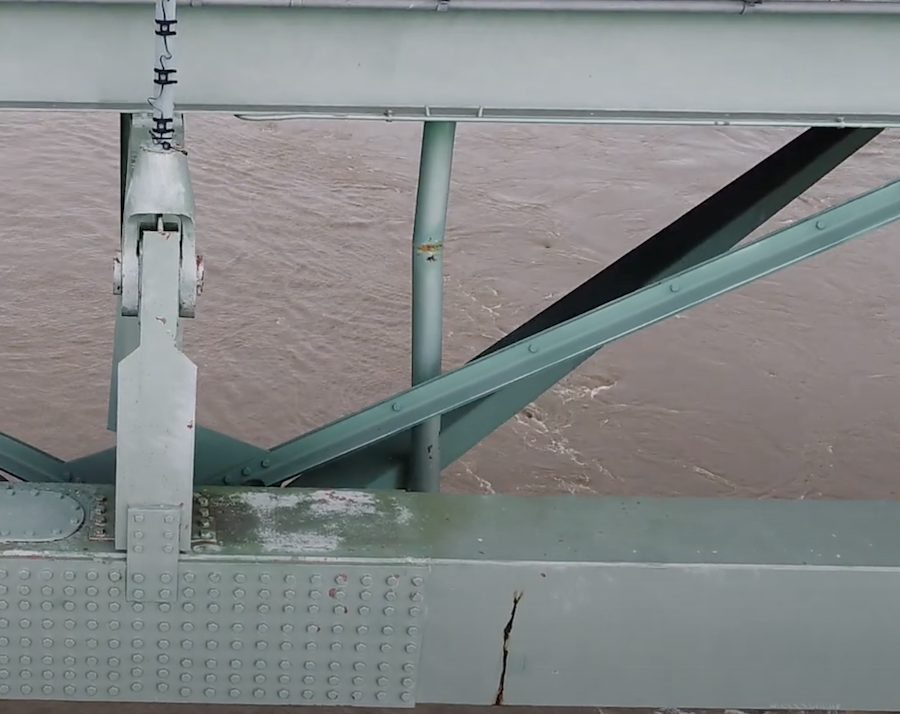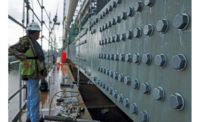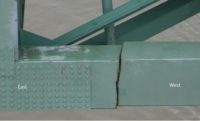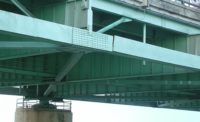The Arkansas Dept. of Transportation (ARDOT) has terminated the employee responsible for inspecting the Interstate-40 Mississippi River bridge after two-year-old drone footage revealed the presence of a tie-beam fracture that forced last week’s emergency shutdown.
Although state officials initially stated that the fracture in one of the 50-year-old bridge’s two tied-arch truss navigation spans was not present during its most recent inspection last September, a May 2019 drone video taken by Michael Baker International clearly shows the break already beginning to form.
ARDOT says the unnamed employee, described as an “inspection team leader” who had been with the agency for about 15 years, oversaw routine physical inspections of the bridge’s fracture-critical elements the following September, and again in 2020.
DOT Director Lorie Tudor said in a Monday press briefing that by either not noticing or not reporting the fracture, “the employee failed to carry out his responsibility correctly.” In addition to referring the case to federal authorities for potential criminal charges, the agency will revisit a number of fracture-critical bridges inspected by the employee in the last year, and review its inspection practices to ensure they’re carried out properly.
“This incident has highlighted a flaw in the processes we have set up to meet the federal standard,” Tudor added, noting that ARDOT’s annual inspections of fracture-critical structures occur twice as often as the Federal Highway Administration's 24-month requirement. She also absolved Michael Baker from any responsibility, noting that the firm’s five-hour drone video was focused solely on assessing the 50-year-old structure’s rods and connectors.
“The fault lies with us that we didn’t see it during our normal inspection process,” Tudor said, adding that the agency has found no evidence that the crack resulted from anything other than normal wear.
The engineering firm's workers noticed the fracture during a separate inspection on May 11, leading to the immediate closure of the bridge to highway traffic. The U.S. Coast Guard has since lifted a temporary halt to barge traffic beneath the bridge.
Meanwhile, ARDOT and the Tennessee Dept. of Transportation, which is responsible for bridge maintenance, have been working with Michael Baker, FHWA and forensic structural experts from design firm HNTB to develop a repair strategy for the fracture, located in a 37-ft-long welded beam section within a 900-ft-long arch span.
Two-phase Repair Approach
According to Rex Vine, ARDOT deputy director and chief engineer, the two-phase approach calls for first stabilizing the beam by adding steel plating to its 1-3/8-in.-thick top and bottom sections, and ½-in.-thick side sections.
A permanent repair design, which is still being refined, would add high-strength steel rods over the fractured section so that the damaged section can be replaced and the bridge reopened.
Vine said during the briefing that RFPs for the work had been sent to numerous contractors around the country, and responses were currently being reviewed. Late Monday, Tennessee DOT announced it has awarded the repair contract to Kiewit Infrastructure Group.
According to a press release, "the selection was based on qualifications, experience and availability of personnel and equipment." Kiewit is expected to start work as early as May 19.
Plates for first-phase repairs total approximately 18,000 lb and are being fabricated by Stupp Bridge Co., Bowling Green, Ky. They are expected to be ready by May 19 and delivered to Memphis for installation.
Kiewit will also provide input on second-phase design, which is still underway.
No timeline has been announced for the repairs, which are being procured under Tennessee DOT’s emergency contracting authority.
The agency also is working with the University of Memphis to identify potential existing research activities on the bridge that might have captured some information regarding the fracture.
“We will continue to look at the bridge for any other long-term issues, to make sure it doesn’t happen again,” Vine said.





Post a comment to this article
Report Abusive Comment